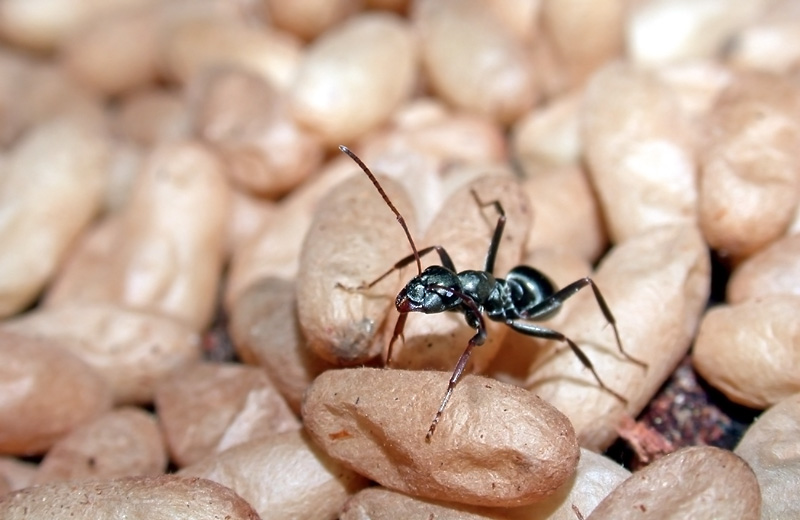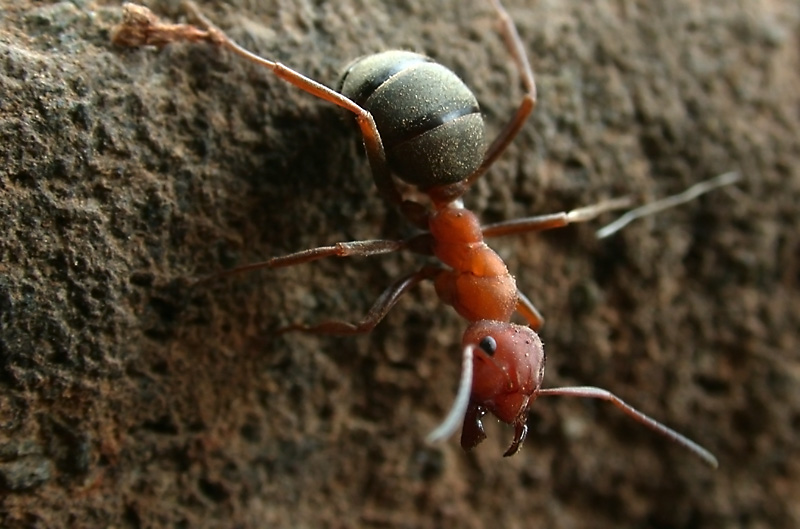|
Formica Rufa Species Group
The ''Formica rufa'' group is a subgeneric group within the genus ''Formica'', first proposed by William Morton Wheeler. This group contains the mound-building species of ''Formica'' commonly termed "wood ants" or "thatch-mound ants", which build prominent nests consisting of a mound of grass, litter, or conifer needles. The species ''Formica rufa'' or the red wood ant is the type species of this subgroup. This particular group can inhabit open deciduous woodlands, dense pine forests, and even moorland. Workers vary in size, the largest reaching about long. They can produce formic acid in their abdomens and eject it in the air when threatened.Dr Timothy BatcheloMsu.edu - Southern red wood ant Formica rufa/ref> The only function of males is to mate in flight with queens. Species previously attributed to the ''Microgyna'' group were transferred to the '' F. rufa'' group by the Wheelers in 1986. Colonies The genetic relationships in ''F. rufa'' group colonies can be complex. Co ... [...More Info...] [...Related Items...] OR: [Wikipedia] [Google] [Baidu] |
Formica Rufa
''Formica rufa'', also known as the red wood ant, southern wood ant, or horse ant, is a boreal member of the ''Formica rufa'' group of ants, and is the type species for that group, being described already by Linneaus in the first version of Systema Naturae from 1758. It is native to Eurasia, with a recorded distribution stretching from the middle of Scandinavia to the northern Iberia and Anatolia, and from Great Britain to Lake Baikal, with unconfirmed reportings of it also to the Russian Far East. There are claims that it can be found in North America, but this is not confirmed in specialised litterature, and no recent publication where North American wood ants are listed mentions it as present, while records from North America are all listed as dubious or unconfirmed in a record compilation. Workers head and thorax are colored red and the abdomen brownish-black, usually with a dorsal dark patches on the head and promensonotum, although some individuals may be more uniform redd ... [...More Info...] [...Related Items...] OR: [Wikipedia] [Google] [Baidu] |
Formica Pratensis
''Formica pratensis'', the black-backed meadow ant, is a species of European red wood ant in the family Formicidae. Systematic ''Formica pratensis'' is divided into these subspecies: *''Formica pratensis nuda'' Ruzsky, 1926 *''Formica pratensis pratensis'' Retzius, 1783 *''Formica pratensis starkei'' Betrem, 1960 Some morphs has previously been named as their own species, like ''F. nigropratensis'' Betrem 1962. and ''Formica nigricans'' Emery in 1909, but is nowdays considered junior synonymes of ''Formica pratensis''. Description ''F. pratensis'' can reach a length of in workers, slightly larger than in other species such as the more common southern wood ant '' F. rufa'' or '' F. polyctena''. Queens reach a size of . The thorax is mainly reddish, while the abdomen and the top of the head are black or dark brown. Generally, this large ant is much darker than other species of wood ants. Their whole bodies are covered with fine hairs. Two large deep black patch are present on t ... [...More Info...] [...Related Items...] OR: [Wikipedia] [Google] [Baidu] |
Formica Obscuriventris
''Formica obscuriventris'' is a species of ant in the family Formicidae. Subspecies These two subspecies belong to the species ''Formica obscuriventris'': * ''Formica obscuriventris clivia'' Creighton, 1940 * ''Formica obscuriventris obscuriventris'' Mayr, 1870 i c g Data sources: i = ITIS, c = Catalogue of Life, g = GBIF, b = Bugguide.net References Further reading * obscuriventris Articles created by Qbugbot Insects described in 1870 {{ant-stub ... [...More Info...] [...Related Items...] OR: [Wikipedia] [Google] [Baidu] |
Formica Obscuripes
''Formica obscuripes'' (western thatching ant) is a species of ant in the family Formicidae. It is native to North America. It produces large mounds covered by small pieces of plant material. The number of adult workers per colony may be as high as 40,000. ''F. obscuripes'' feeds upon a number of insect species, consumes nectar from homopterous insects they tend, and occasionally eats plant tissue. Nests ''F. obscuripes'' creates distinct, dome-shaped mounds composed of varying materials found in the nest's surrounding environment. This composition is primarily vegetation and is commonly called "thatch". The mounds are typically constructed in areas devoid of cover to expose the nest to sunlight. The size of these mounds is highly variable and is mostly determined by the age and health of the colony. The height ranges from 1 to 18 inches (15–45 cm), although nests of larger heights are not uncommon, and can extend down to 4 ft (1.2 m) in the ground, with chambe ... [...More Info...] [...Related Items...] OR: [Wikipedia] [Google] [Baidu] |
Formica Mucescens
''Formica'' is a genus of ants of the family Formicidae, commonly known as wood ants, mound ants, thatching ants, and field ants. ''Formica'' is the type genus of the Formicidae, and of the subfamily Formicinae. The type species of genus ''Formica'' is the European red wood ant ''Formica rufa''. Ants of this genus tend to be between 4 and 8 mm long. Habitat As the name wood ant implies, many ''Formica'' species live in wooded areas where no shortage of material exists with which they can thatch their mounds (often called anthills). One shade-tolerant species is '' F. lugubris''. However, sunlight is important to most ''Formica'' species, and colonies rarely survive for any considerable period in deeply shaded, dense woodland. The majority of species, especially outside the ''F. rufa'' species group, are inhabitants of more open woodlands or treeless grassland or shrubland. In North America, at least, these habitats had a long history of frequent landscape-scale fires t ... [...More Info...] [...Related Items...] OR: [Wikipedia] [Google] [Baidu] |
Formica Microgyna
''Formica'' is a genus of ants of the family Formicidae, commonly known as wood ants, mound ants, thatching ants, and field ants. ''Formica'' is the type genus of the Formicidae, and of the subfamily Formicinae. The type species of genus ''Formica'' is the European red wood ant ''Formica rufa''. Ants of this genus tend to be between 4 and 8 mm long. Habitat As the name wood ant implies, many ''Formica'' species live in wooded areas where no shortage of material exists with which they can thatch their mounds (often called anthills). One shade-tolerant species is '' F. lugubris''. However, sunlight is important to most ''Formica'' species, and colonies rarely survive for any considerable period in deeply shaded, dense woodland. The majority of species, especially outside the ''F. rufa'' species group, are inhabitants of more open woodlands or treeless grassland or shrubland. In North America, at least, these habitats had a long history of frequent landscape-scale fires t ... [...More Info...] [...Related Items...] OR: [Wikipedia] [Google] [Baidu] |
Formica Laeviceps
''Formica'' is a genus of ants of the family Formicidae, commonly known as wood ants, mound ants, thatching ants, and field ants. ''Formica'' is the type genus of the Formicidae, and of the subfamily Formicinae. The type species of genus ''Formica'' is the European red wood ant ''Formica rufa''. Ants of this genus tend to be between 4 and 8 mm long. Habitat As the name wood ant implies, many ''Formica'' species live in wooded areas where no shortage of material exists with which they can thatch their mounds (often called anthills). One shade-tolerant species is '' F. lugubris''. However, sunlight is important to most ''Formica'' species, and colonies rarely survive for any considerable period in deeply shaded, dense woodland. The majority of species, especially outside the ''F. rufa'' species group, are inhabitants of more open woodlands or treeless grassland or shrubland. In North America, at least, these habitats had a long history of frequent landscape-scale fires t ... [...More Info...] [...Related Items...] OR: [Wikipedia] [Google] [Baidu] |
Formica Integroides
''Formica integroides'', also known as the Vinegar Ant, is a species of ant in the family Formicidae. References Further reading * External links * integroides Articles created by Qbugbot Insects described in 1913 {{ant-stub ... [...More Info...] [...Related Items...] OR: [Wikipedia] [Google] [Baidu] |
Formica Fossaceps
''Formica fossaceps'' is a species of ant in the genus ''Formica ''Formica'' is a genus of ants of the family Formicidae, commonly known as wood ants, mound ants, thatching ants, and field ants. ''Formica'' is the type genus of the Formicidae, and of the subfamily Formicinae. The type species of genus ''For ...'' (wood ants, mound ants, and field ants), in the family Formicidae.Sharkey M.J. (2007). ''Hylogeny and Classification of Hymenoptera''."Phylogenetic relationships among superfamilies of Hymenoptera", Sharkey M.J., Carpenter J.M., Vilhelmsen L., et al. 2012. ''Cladistics'' 28(1): 80-112. This species is a member of the ''Formica rufa'' species group. References Further reading * fossaceps Insects described in 1942 {{Ant-stub ... [...More Info...] [...Related Items...] OR: [Wikipedia] [Google] [Baidu] |
Formica Dakotensis
''Formica dakotensis'' is a species of ant in the family Formicidae. References Further reading * dakotensis Articles created by Qbugbot Insects described in 1893 {{ant-stub ... [...More Info...] [...Related Items...] OR: [Wikipedia] [Google] [Baidu] |
Formica Criniventris
''Formica'' is a genus of ants of the family Formicidae, commonly known as wood ants, mound ants, thatching ants, and field ants. ''Formica'' is the type genus of the Formicidae, and of the subfamily Formicinae. The type species of genus ''Formica'' is the European red wood ant ''Formica rufa''. Ants of this genus tend to be between 4 and 8 mm long. Habitat As the name wood ant implies, many ''Formica'' species live in wooded areas where no shortage of material exists with which they can thatch their mounds (often called anthills). One shade-tolerant species is '' F. lugubris''. However, sunlight is important to most ''Formica'' species, and colonies rarely survive for any considerable period in deeply shaded, dense woodland. The majority of species, especially outside the ''F. rufa'' species group, are inhabitants of more open woodlands or treeless grassland or shrubland. In North America, at least, these habitats had a long history of frequent landscape-scale fires t ... [...More Info...] [...Related Items...] OR: [Wikipedia] [Google] [Baidu] |




